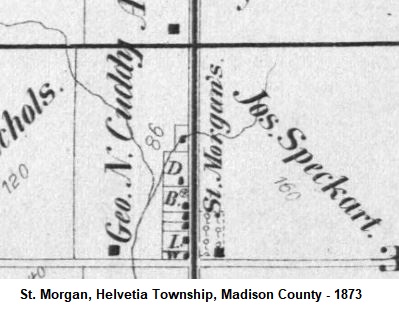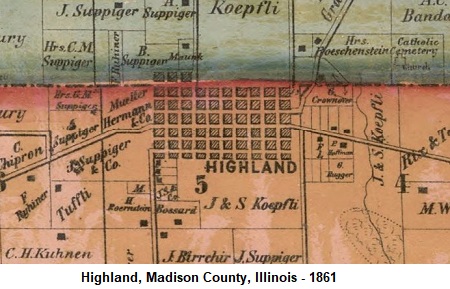Early Highland History (Includes Sebastopol and St. Morgan
HIghland, Sebastopol, and St. Morgan Newspaper Articles
Early Settlers
The settlement of this part of the county began as early as 1804,
but these were very few and far between. In 1809, Mrs. Howard, a
widow with several grown sons and daughters, emigrated from
Tennessee and made her home on the edge of Looking Glass Prairie,
about one mile northwest of the present town of Highland. Looking
Glass Prairie was said to have looked more like a great park than a
wild country. It was covered with luxuriant grass and flowers of all
colors, with beautiful hills covered with fine trees. The next year,
1810, Abraham Huser, who had married one of the Howard daughters,
began making an improvement on his land, about a mile farther north.
Ten miles to the south, a few white men had erected their cabins;
likewise to the east on Shoal Creek. There were eleven families in
all in this part of the county, who had to seek the protection of
Chilton's Fort during the troubles with the Native Americans during
the War of 1812-14. In 1831, immigrants from Switzerland began to
arrive, followed in increasing numbers by other Swiss and Germans.
Joseph Suppiger built the first frame house on Looking Glass
Prairie,
which later became about the center of Highland. When the first larger
number of Swiss immigrants, who followed the original Swiss settlers
(the Koepflis and Suppigers), arrived in 1833, they bought the
existing pioneer farms – usually a log cabin and several acres of
cultivated land. The squatter who had built the log cabin would then
pack his few belongings on a horse, with his wife and children on
another, and away they would go – armed with a shotgun. The first
home of the Koepflis became the headquarters for the district, being
besieged by people from all directions who came to see Doctor
Koepfli – the only doctor within miles – or for information
regarding the purchase and sale of lands. For immigrants, it was the
first place of refuge.
Founding of
Highland
In 1837, General James Semple, then a member of the House of
Representatives in Illinois, selected section 5 of Helvetia Township
in
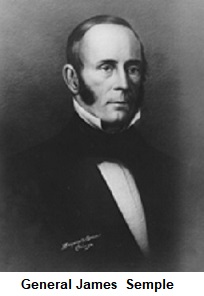 Madison County for the site of a future town. A railroad
development was in planning stages, and an appropriation of
$1,600,000 was made for the construction of this and the
Alton–Shawneetown Railroad. One day, quite unexpectedly, two
strangers appeared on horseback. One of these was General Semple,
and the other Joseph Suppiger. General Semple stated that he wanted
Suppiger, Dr. Koepfli, and James Reynolds to join as founders of the
new town. An agreement was made, deciding that 100 acres were to be
platted into forty-five blocks, each 300 feet square, with the usual
streets and alleys, with the central block being reserved for public
or school purposes. The survey was made by the then county surveyor,
Benaiah Robinson. In naming the town, Suppiger and Koepfli proposed
either Helvetia or New Switzerland, but General Semple, being of
Scotch descent, and his new associates also hailing from mountain
regions, proposed Highland, which was adopted. The original plat of
the town, as recorded, shows not only the projected railroad, but
also the depot grounds and an additional railroad named “Die
Belleville and St. Louis.” Zschokke Street was made considerably
wider than others for the purpose of the prospective railroad
right-of-way, but that railroad was not completed. The plans were
presumably abandoned during the panic of 1837.
Madison County for the site of a future town. A railroad
development was in planning stages, and an appropriation of
$1,600,000 was made for the construction of this and the
Alton–Shawneetown Railroad. One day, quite unexpectedly, two
strangers appeared on horseback. One of these was General Semple,
and the other Joseph Suppiger. General Semple stated that he wanted
Suppiger, Dr. Koepfli, and James Reynolds to join as founders of the
new town. An agreement was made, deciding that 100 acres were to be
platted into forty-five blocks, each 300 feet square, with the usual
streets and alleys, with the central block being reserved for public
or school purposes. The survey was made by the then county surveyor,
Benaiah Robinson. In naming the town, Suppiger and Koepfli proposed
either Helvetia or New Switzerland, but General Semple, being of
Scotch descent, and his new associates also hailing from mountain
regions, proposed Highland, which was adopted. The original plat of
the town, as recorded, shows not only the projected railroad, but
also the depot grounds and an additional railroad named “Die
Belleville and St. Louis.” Zschokke Street was made considerably
wider than others for the purpose of the prospective railroad
right-of-way, but that railroad was not completed. The plans were
presumably abandoned during the panic of 1837.
The next step taken was a public sale of town lots on September 16,
1837. Constable Nic Kile was the auctioneer. The attendance was not
large, due to the sparsely settled area, and only a small number of
lots were sold. Wesley Dugger, from the neighborhood of the present
town of St. Jacob, was the only one present from a distance. He
bought a corner lot on which he built a frame house and started a
small country store.
Immediately after the sale of lots, Joseph Suppiger began building a
steam mill, thus affording welcome employment to others. Because of
the steam mill, a log cabin of 20 feet square was constructed, in
which on New Year’s Day, 1838, the first public dance occurred. In
the mill, Sylvan Utiger installed a turnery, for the making of
bedposts, and naves for wagons. Settlers soon began building frame
houses and improving their log cabins. For heating, cooking and
baking, they all had large fireplaces, as cast-iron stoves were too
expensive. The meals at that time consisted usually of cornbread,
bacon or venison. Deer were so numerous that the meat could be
bought for less than one cent per pound. The Methodist Hill at that
time was the meeting place of deer, rabbits and wolves – the latter
being especially severe on young pigs. All the animals were allowed
to run at large before the stock law was enacted, which required all
occupied or improved buildings in town to be fenced in to keep
animals out.
The post office was established in 1839 with David Thorp as
postmaster.
Soon after the town of Highland was laid out, Swiss colonists were
reinforced by immigrants from Baden. In 1840, the families of
Bender, Meyer, Hammer, and Bader arrived. In 1841, seventy-two
immigrants arrived, included the families of Hotz, Federer, Rall,
Trautner, Fellhauer, Essenpreis, Weber, Kustermann, Holizinger,
Voegele, Schwarz, Frey, Schaefer, Bellm, Barth, Koch, Winter, Woll,
Ehrhardt, Hirsch, Weidner, Knopf, Metzger, Hoffmann, and Zopf. Most
of these families settled east or northeast of Highland, in a
semi-circle, and were devout Catholics. In 1844, they erected their
first church edifice. Rev. Father P. Limacher served as their first
priest.
Incorporation
In 1865, Highland was incorporated and the first town election was
held. Jacob Eggen was elected president, with Joseph Speckart, Henry
Weinheimer, Xavier Suppiger, and Frank Appel as trustees. Berthold
E. Hoffmann was clerk, and John Menz, treasurer.
The Railroad
Highland had no railroad at this time, and when in 1867 the builders
of the Vandalia line proposed to run a road through the town if
money was contributed, the citizens agreed to $10,000. A road was
completed in 1868.
Progress
In 1884, discussion was held to organized Highland as a city. The
proposition was hotly contested for fear the town might be run
heavily in debt. The proposition carried by a large vote, however.
Election of city officers was held May 6, 1884, with Fred B.
Suppiger as Mayor, Alexander Beck, city clerk; Adolph Mueller,
treasurer; and aldermen J. George Dumbeck, Jacob Grossenbacher, John
Guggenbuehler, John Wildi, Adolph Ruegger, and John H. Hermann. A
suitable two-story city hall was constructed in 1884, with the upper
floor for meetings and offices, and the lower floor for fire engines
and the jail.
Highland was one of the first towns in Madison County to install
electric lights. The plant was first owned by private parties, but
after a few years, it was purchased by the city.
Highland
Businesses
The founding of the town was succeeded by the terrible commercial
crisis of 1837. No debts could be paid except in cattle or produce.
Despite this, the population and business activity began to grow. A
steam mill, as previously mentioned, was erected as early as 1837 by
Joseph Suppiger & Co. (Joseph Suppiger, Dr. F. Ryhiner, and Caspar
Meyer). The capacity of the mill was about 30 barrels of flour in 24
hours. A saw mill was attached. From 1840 to 1850, the firm was
composed of Joseph, Melchior, and Bernard Suppiger, James Reynolds,
and David Thorp. A fourth brother, David, bought Bernard’s share in
1850. In 1854, James Reynolds sold out to Bernard Suppiger, who then
became again a partner of the firm. In 1866, the mill passed into
the hands of David Suppiger, Robert Suppiger (oldest son of
Bernard), Hale M. Thorp, and Henry Weinheimer. The latter sold his
share to Otto Suppiger (youngest son of Bernard), and Edwin J. Raith
in 1880. The first building was erected by Joseph Suppiger, and the
machinery for both grist and corn mill by an eastern millwright
named Gale. In 1857, the whole mill was remodeled, the saw mill
removed, and a new engine constructed under the supervision of
Captain Julius Raith.
The first mechanic of Highland was a wagon maker named Krucker, from
St. Gall, Switzerland. Krucker, along with a blacksmith from Germany
by the name of Lang, were put to work in 1839 by Jacob Eggen making
the first wagon, which they completed to perfection and established
a reputation that brought them abundant work.
Charles Kinne started a harness shop in Highland. The first store in
Highland was opened by Elijah Ellison, on the site of the Highland
House. David Thorp opened a store in 1838 or 1839 (which later
became the site of a bank) and became the first postmaster of
Highland.
Jacob Eggen, who arrived in Highland in 1833, started a brickyard,
and connected a pottery with it. The first vessels for the St. Louis
White Lead Works were made in this pottery. Mr. Eggen was also the
founder of a distillery and later a bakery.
In the summer of 1843, Joseph and Salomon Koepfli, upon their return
from Switzerland, built their fine, large residence on the hill just
north of town, and converted the grove on the north side into a neat
park. The same year, a number of buildings were erected and several
stores opened. Peter Tuffli and his stepfather, John Laubinger,
bought the house in which Elijah Ellison operated a store, and
opened the first regular meat shop. About the same time, J. R.
Blattner began building the noted New Switzerland House, which
existed about fifty years until John Wildi bought it and erected in
place of it his fine mansion.

A wool-carding machine was erected by N. Smiley in 1843, and in
later years it was owned by Mr. Stahl, who converted it into a yarn
factory. The business was continued successively by Bosshard,
Feickert & Co., Bosshard, Pfenninger & Co., and by Charles Bosshard,
up to September 1874.
John Guggenbuehler founded the Jefferson Brewery in 1843. It later
passed into the hands of Daniel Wild. In 1865, it was consolidated
with the Highland Brewery, which was founded in 1854 by Charles L.
Bernays. In 1856, Bernays took Gerhard Schott and M. F. Schott as
partners. Bernays sold his interest in the brewery to the Schotts in
1857. Soon after, Gerhard Schott sold his interest, and Martin F.
and Christian Schott remained sole proprietors until 1870, when
Christian Schott withdrew from the business.
Jacob Eggen, together with Ludwig Gruetli, opened a distillery in
1844, with Henry Hermann and George Ruegger as partners. In 1849,
the business passed into the hands of Anthony Miller, Henry Hermann,
and J. J. Spindler, and was successfully operated until 1865, when
the partnership was dissolved.
In 1850, Henry Hermann, John Leder, and C. H. Seyht, with a capital
stock of $100,000, founded the Highland City Mills.
In 1859, the Highland library was organized, with A. E. Bandelier as
President. In 1866, the Highland Turn Verein was organized. A public
hall was erected, large enough to comfortably seat 700 persons. In
the hall were musical performances and political meetings.
After the Civil War, Highland had a population of nearly 2,000
people. The log cabins and light frame buildings were disappearing,
being replaced with substantial brick buildings. Other businesses
were founded such as the Highland Foundry, N. Rohr’s planing mills
and door and sash factory, Grossenbacher’s Custom Mills, and the
Highland Mineral Water Factory. Grain elevators were erected near
the depot, to facilitate shipment of agricultural products.
In 1885 the Helvetia Milk Condensory was founded, which manufactured
evaporated milk. The well-known “Pet” and “Highland” brands were
popular, with Pet being sold to the domestic trade, and the latter
exported and sold to the army and navy. Through perseverance, the
company prospered. Their eight plants (Highland, Greenville, Ohio,
Wellsboro, Pennsylvania, Michigan, Kansas, Wisconsin, and Westfield,
Pennsylvania) turned out from eight to ten carloads of finished
product daily. Although the company was not the inventor of the
manufacture of evaporated milk, they were the first to put the
product into successful practice on a commercial scale. The first
board of directors were Dr. Knoebel, John Wildi, George Roth, Fred
Kaeser, and Louis Latzer. Dr. Knoebel served as president, and John
Wildi as secretary and treasurer.
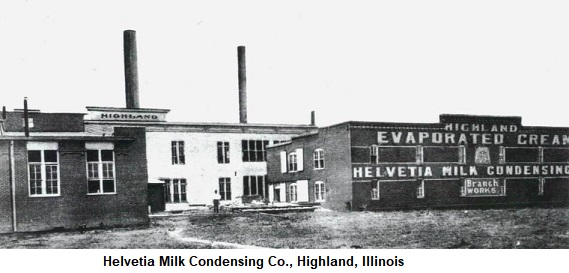
Highland Embroidery Works was founded in 1881 by John Rush of
Switzerland, but established in 1883 by J. J. Spindler Jr. Numerous
machines were imported from Switzerland and Germany, and about
twenty-five men and seventy-five to one hundred girls were employed.
The Stocker Artificial Stone and Gravel Company was established in
1903. The company manufactured plain and ornamental building blocks
and other concrete articles. They constructed concrete sidewalks,
bridges, foundation for houses, etc. Fred Stocker served as
president, with Ferd Krenzer as secretary and treasurer.
Highland Banks
The First National Bank was evolved from the bank of Kinne & Pabst
and the Highland Bank. Kinne & Pabst founded their bank in 1890, and
in 1891 the Highland Bank was incorporated. On March 5, 1903, the
name was changed to the First National Bank of Highland.
The State & Trust Bank was organized May 3, 1903. John Wildi served
as president, L. J. Ruhr, vice-president, and Louis Blattner,
cashier.
The East End Bank was organized October 28, 1908. Edward Feutz
served as president, and Louis Miller, vice-president; Frank Zolk,
secretary, and L. A. Schreiber, cashier.
Early Highland
Schools
Although there was no schoolhouse, Miss Slater was retained as
teacher. She taught in the homes of various families of the
students. Joseph Suppiger, in about 1839 or 1840, raised funds to
erect a schoolhouse. It was built by Joseph Mueller on what is now
called Methodist Hill, at the expense of $300. The schoolhouse on
Methodist Hill was open to all, and was also used for religious
services. This schoolhouse soon proved to small, and on October 27,
1843, it was decided to erect a stone building, 40x24 feet. This
building was completed in 1844. This schoolhouse burned down in the
S pring of 1850. Joseph Suppiger called a public meeting, and it was
decided to raise money for the erection of a two-story brick
building of four rooms, upon the public or school square. This
building was soon erected, with one room used for the regular
English public school, and the other three rooms by private
teachers. Records show that Miss Emily S. Thorp was the first
teacher of this public school. Due to rapid increase of population,
this schoolhouse soon became insufficient. In 1867, another
two-story brick building of four rooms was erected. Again, in 1893,
the two buildings proved inadequate. In 1894, a modern building of
ten spacious rooms, at a cost of $24,000 was constructed. The two
old schoolhouses were torn down.
Early Highland
Churches
The German Catholic Church - On December 26, 1843, the Catholics of
Highland decided to build a church. Solomon Koepfli, John Schwartz,
Conrad Bader, William Lang, Dr. Caspar Koepfli, John Frey, Theodore
Mueller, Nic Voegele and Jacob Durer were appointed to take the
necessary steps. The cornerstone was laid May 1, 1844 by Father J.
Catting. Eventually the small church was found inadequate, so in
October 1853, a new brick church, 110x45 feet, was completed in
1856. The first frame church was used as a parochial school until
the convent building was completed in 1866. The rectory was erected
in 1857.
The German Methodist Church was organized in 1846. The church was
built in 1847, and the parsonage was built in 1876 or 1877. Rev.
William Fiegenbaum was the first resident pastor.
The French and English Congregational Church – The Congregational
Church of Highland was evolved out of the French Church, which had
its beginning with the coming of Rev. Francis Vulliet from
Switzerland in 1848. He was an ordained minister for more than
twenty-two years, but refused to obey the mandates of the political
party in power. He immigrated to American with his family, arriving
in Highland in 1848. He immediately began religious services in his
and other homes of French-speaking families until in 1859 a brick
church was built on Methodist Hill, named the French Evangelical
Church. In 1874, Rev. Francis Vulliet died, and his son, Rev. Louis
Vulliet, was elected pastor. The congregation joined the Southern
Association of Congregational Churches in 1876, with Louis Vulliet
as minister until 1886. A new church building was erected in 1887.
The Highland
Militia
In 1844, when war with Mexico was expected, 3 militia companies were
organized – an artillery company with Jacob Eggen as Captain, an
infantry company with Captain John Guggenbuehler, and a cavalry
company under Captain Richardson. The members of the first two
companies were all Germans or Swiss-Germans, while in the cavalry
company, only three Swiss were enlisted. The three Highland
companies formed their battalion and elected Jacob Eggen as Major.
In 1848, the population had increased, and the number of men was
brought up to 250. The state furnished a cannon for the artillery
company, which Major Eggen selected and brought over from Alton. He
was met by the company at Silver Creek, north of Highland, where the
men formed in position for parade to Highland, after firing three
salutes. This event was witnessed by the entire population. 1848 was
the last year of the existence of this militia. The cannon was later
used for “thunder” on the fourth of July and other festivals. It was
later mounted in Lindendale Park as an ornament. During the Civil
War, Highland furnished more than its quota of men for the
preservation of the Union.
EARLY HISTORY OF SEBASTOPOL
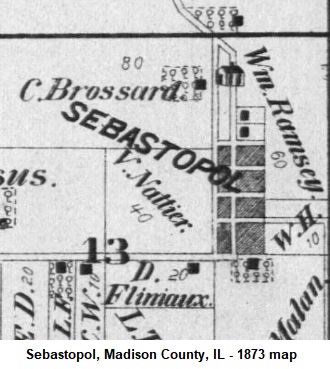
Sebastopol was a rich, agricultural section inhabited by industrious
people. Timothy Gruaz laid out the little town of Sebastopol in
1860, after opening a store in 1858 on the north side near the
Ramsay farm. Eventually the village had about a dozen houses, with a
general store, two blacksmiths (J. C. Luchsinger and Elisha
Demoulin), a cartwright (Rud Kaufmann), and a shoemaker (Aug
Kkeiser). Gruaz’s store came into the hands of William Hagnauer Sr.,
and then years later to J. C. Steiner, and lastly to Elisha
Demoulin, who closed the store in about 1900. The blacksmith,
cartwright, and shoemaker went out of business about the same time,
so that only homes remained. During the best years of this village,
Anthony Hoefli conducted a small tavern.
EARLY HISTORY OF ST. MORGAN
